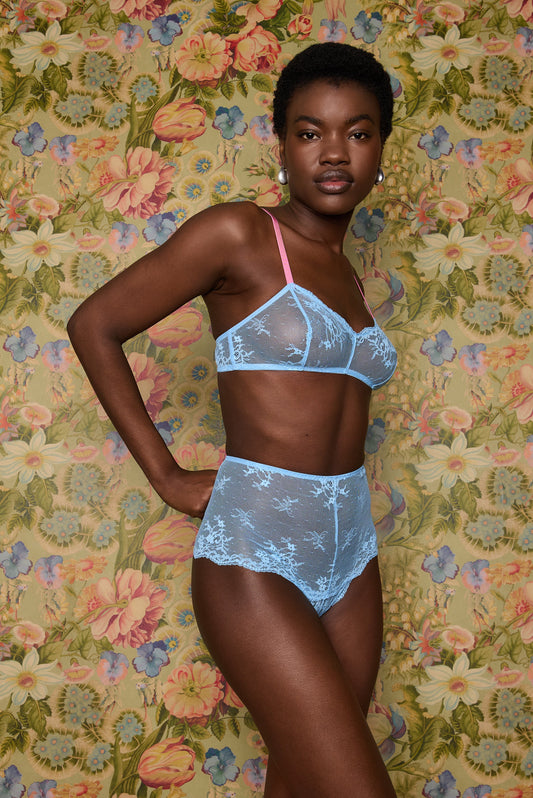

Our Values
We’re a small, family run business. As big believers in Karma, producing responsibly is our priority. Our focus is on making product that lasts, fits well enough to wear every day, and is manufactured using certified and sustainable materials. We’re not perfect, but we’re focussed on becoming the most responsible version of ourselves.

Our Materials
We work seasonally to update our responsibility credentials. Our bespoke laces are designed on an exclusive basis, and all are made using at least 83% recycled materials. Our bespoke embroidery, tulle and threads are also produced using recycled materials.
That said, we still recognise the sustainability limitations to using synthetic materials, even where they're recycled. The materials are difficult to recycle again at the end of their useful life and can end up in landfill. And so, we apply our focus on creating products that have a long lifespan, as well as working to increase our natural and organic material content for the future.
All our material and component suppliers, as well as our dyehouses, meet REACH standards. Our materials are also OEKO-TEX certified, which means they’re non-toxic and free from harmful chemicals. We use third-party material certifications (GRS, GOTS, OCS, FSC) to make sure our recycled and organic materials are also verified.

Excess Inventory
The fashion industry has a poor reputation when it comes to the topic of waste in the production of finished goods, as well as the production of materials. This is because it can be difficult for brands to accurately predict how much stock, and in what styles, they'll need for each season.
We work around this issue in a few ways. We tread cautiously when planning the amount of stock we intend to make for future seasons and as we're a self-funded family business, we aren’t under pressure by external financial investors to grow our sales revenue at an extreme or unsustainable pace. We also limit the number of different designs we produce, which means we’re able to achieve a higher sell-through per style, and therefore minimise excess stock at the end of the season. Limiting the number of styles we make means we’re able to focus our attention on making sure the fit and quality of a new colour way is perfected and consistent each season, which has a great effect on the longevity and wearability of our product. Finally, we also use the same fabrics and trims multiple seasons in a row, which means we’re consolidating materials as much as possible to avoid wastage.
If we are left with any unsold items or samples, we either sell these at a sample sale, donate them to charity, or recycle them via a third party. Ultimately, we make sure that nothing ever goes to waste.

Our Packaging
Our FSC-certified paper and cardboard packaging is made from a blend of sustainably sourced, replanted trees and recycled materials, and is also fully recyclable or compostable. Our care labels are also produced using 100% recycled nylon.
We’ve phased out all plastic except for our polybags, which are currently made from 100% recycled plastic. The bags are also recycled after use by our warehouse and wholesale customers. We’re looking at alternative options for the future, in the goal to step away from all plastics completely.

Giving Back
Since 2021, we’ve been collaborating with environmental charities whose work we align with and feel inspired by.
To date, we’ve donated over £47,000 to the below organisations:
The Woodland Trust
eXXpedition
Rewilding Britain
Organic Cotton Accelerator
DIRT
Surfers Against Sewage
London Wildlife Trust
The Fungi Foundation
Farmers Footprint
Grow for Life

Our Supply Chain
One of the fashion industry’s greatest challenges to becoming more sustainable lies in the traceability of its supply chains. The number of parties involved in creating lingerie is substantial, from the raw material producers, to the mills creating yarns and fabrics, dye houses and component manufacturers, right the way through to the final garment manufacturers. A traditionally opaque system, we’re on a mission to increase traceability in each of our supply chains to achieve greater transparency on the environmental and ethical standards of each supplier. We have clear visibility of all our Tier 1 manufacturers (manufacturers of our end product) and perform a thorough assessment of their ethical and environmental standards before working with them. We also have 100% supply chain visibility with our Tier 2 suppliers (fabric mills), all of whom are, at the very least, OEKO-TEX certified. At the moment, we have transparency on 60% of our Tier 3 suppliers (dye houses and yarn spinners).

Our Factories
We manufacture our lingerie and sleepwear across three factories based in Tunisia and China. We choose our factories based on local availability of materials, high ethical and environmental standards, and regional ability and techniques.
We use certified third-party audits via SEDEX, produced on an annual basis, to evaluate the social and ethical standards of our factories. Our factories all follow the Ethical Trading Initiative. This includes (but is not limited to), ensuring workers are paid at least the living wage or higher, no discrimination is practiced, working conditions are safe and hygienic, and workers having the right to join or form trade unions.
The names and addresses of our factories are listed below:
Les Ateliers ISA - Sfax, Tunisia
John Stewart Bennett - Guangzhou, China
Kam Run - Dongguan City, Guangdong Province, China
New in
-
Manon Floral Lace Bralette
Regular price Afl145Regular priceUnit price / per -
Romilly Clean Tulle Underwire Bra
Regular price Afl145Regular priceUnit price / per -
Echo Butterfly Embroidery Underwire Bra
Regular price Afl180Regular priceUnit price / per -
Priya Heart Embroidery Bralette
Regular price Afl145Regular priceUnit price / per









